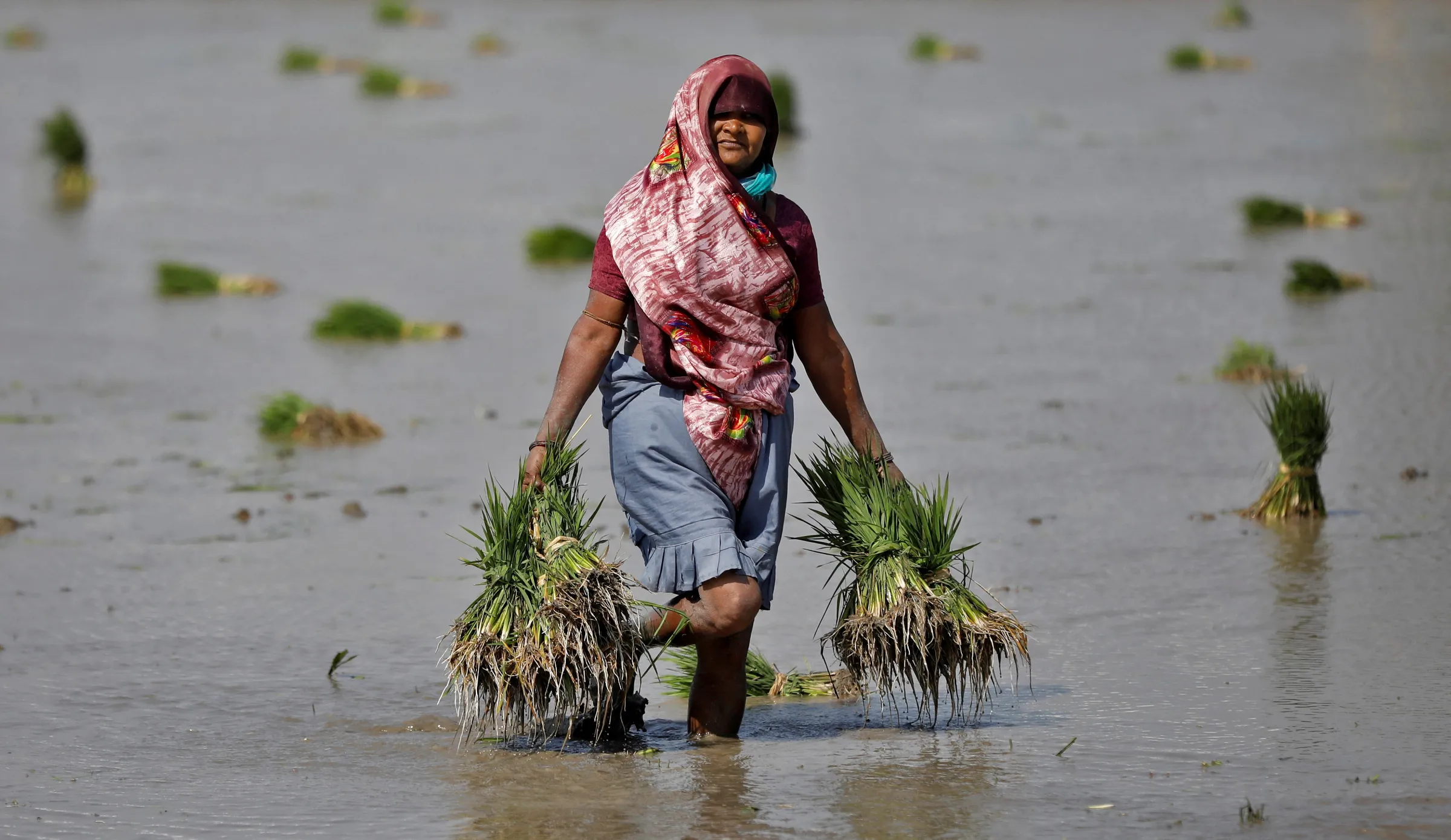Can parametric insurance change the game in climate disasters?

A farmer carries rice saplings in her field on the outskirts of the western Indian city of Ahmedabad, India, February 1, 2023. REUTERS/Amit Dave
What’s the context?
Insurance that pays out pre-set sums instead of indemnifying losses is becoming more common as floods, hurricanes and heatwaves intensify
- Parametric models pay out when pre-set markers are hit
- Can deliver faster disaster aid than traditional insurance
- Industry experiments with new models for climate losses
NEW DELHI - As climate-fuelled disasters become more frequent and intense, companies, countries and aid workers are experimenting with new models of insurance and financial help to manage growing risks and losses - among them, parametric insurance.
Parametric policies pay out a pre-agreed amount of money if certain criteria - such as an amount of rainfall or wind speed - are met, the assumption being that damage will have occurred under those conditions.
That can cut out the need for a claims expert visit to assess damage before the insurer pays, as with traditional insurance, and allow for quicker payouts.
Parametric insurance programmes are being rolled out to varying degrees of success around the world, from the Unites States to India.
Here's how it works - and where it is catching on:
What are the benefits compared to traditional insurance?
In more traditional indemnity insurance models, people affected by disasters put in a claim when they suffer a loss and then wait for it to be assessed and paid, a process that can drag on and slow recovery efforts.
Because parametric insurance payouts are triggered automatically by pre-set markers, help arrives faster and without the red tape and cost of visits by claims assessors.
"You're not sending out claims adjusters because you're not concerned, for purposes of the payout, with the magnitude of the damage," said Jeff Dunsavage with the Insurance Information Institute, an industry research group.
By avoiding the claims assessment process, parametric insurance might also reduce the number of challenges by clients over payouts.
What are the downsides?
While people with parametric insurance can receive faster payouts, they can miss out on compensation if losses occur when the predetermined criteria are not reached.
A homeowner who took out hurricane parametric insurance triggered at a certain wind speed, for instance, might get no payout if they were hit instead by a less windy storm, but one that dumped a lot of rain as it moved slowly by, said Jonathan Charak, vice-president of insurance firm Zurich North America.
"That's a horrible situation to be in," he said.
The pre-agreed payment might also not be enough to cover the total losses.
How widely is parametric insurance used?
Parametric insurance has been used around the world for years, from protecting crops in Africa, to property in the hurricane-prone Caribbean.
Since 2007, the Caribbean Catastrophe Risk Insurance Facility, now known as CCRIF SPC, has paid out more than $240 million to help countries recover from disasters caused by earthquakes, tropical storms and heavy rainfall.
Many countries, including the United States and some in Asia, have started experimenting with parametric insurance.
The state of Utah, for instance, benefitted from a parametric earthquake policy that swiftly paid out after a 5.7-magnitude quake in March 2020.
Philippines ran a two-year long pilot parametric insurance programme in 2017 to protect individuals against typhoons, in partnership with the World Bank.
In India too, many forms of parametric insurance are being tested. Nagaland state government, in the country's northeast, is using the tool to protect losses from heavy rainfall events.
In western India, a labour association in the state of Gujarat is piloting parametric insurance to protect outdoor women workers against extreme heat.
And in the south, the milk federation of the state of Kerala is using the insurance to protect its farmers against low milk yield from animals due to heat stress.
Are parametric models more sustainable as insurance claims rise?
Parametric insurance may not be suited to replacing traditional indemnity insurance, but it can act as a valuable supplement in certain cases or provide at least some compensation in poorer places with little insurance coverage, experts say.
Backers would also like to see more regional and global parametric risk pools created, to help spread the rising costs of insurance and keep coverage affordable.
"There isn't yet this global fund whereby (if) an event occurs anywhere in the world, money gets (paid). I'd like to see that happen," said Toby Behrmann of Global Parametrics, a London-based group that works on parametric models.
(Reporting by David Sherfinski and Bhasker Tripathi; Editing by Helen Popper and Jon Hemming.)
Context is powered by the Thomson Reuters Foundation Newsroom.
Our Standards: Thomson Reuters Trust Principles
Tags
- Extreme weather
- Government aid
- Climate finance
- Climate policy
- Loss and damage



















